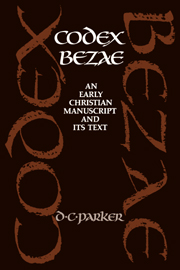Book contents
- Front Matter
- Contents
- List of illustrations
- Preface
- Abbreviations and textual conventions
- Introduction
- PART I The palaeography
- Chapter One The codex and the hand
- Chapter Two The punctuation
- Chapter Three The secondary hands
- Chapter Four Towards the codicology of a bilingual codex
- PART II The scribe and the tradition
- PART III The correctors
- PART IV The bilingual tradition
- Part V Text and codex
- Appendices
- Plates
- Notes on the plates
- Indexes
Chapter Two - The punctuation
Published online by Cambridge University Press: 09 November 2009
- Front Matter
- Contents
- List of illustrations
- Preface
- Abbreviations and textual conventions
- Introduction
- PART I The palaeography
- Chapter One The codex and the hand
- Chapter Two The punctuation
- Chapter Three The secondary hands
- Chapter Four Towards the codicology of a bilingual codex
- PART II The scribe and the tradition
- PART III The correctors
- PART IV The bilingual tradition
- Part V Text and codex
- Appendices
- Plates
- Notes on the plates
- Indexes
Summary
This section is purely descriptive. A discussion of the purpose of the punctuation will be found in the chapter on the sense-lines (chapter 5).
Examination indicates that the punctuation is somewhat different from the description given by Scrivener (pp.xviiif). Lowe's account (CLA 2,140, both editions) is unfortunately even less complete. Besides the fact of the sense-lines themselves, there are eight phenomena to be noticed.
1. A line projecting into the left-hand margin, with some initial letters enlarged (see below).
2. A double point, like a modern colon, found within a line (occasionally at the end), sometimes followed by an enlarged initial letter.
3. A medial point, also found within a line, but sometimes at the end.
4. A large space, sometimes followed by a large initial letter.
5. A small space.
6. A large space with a medial point in it.
7. A high point.
8. A quotation from the Old Testament indented.
The scribe also used the diaeresis and apostrophus. His practice is clearly described by Scrivener (p. xix), and need not concern us further. The use of the terms στλγμή μέση and στλγμή τελεία for the middle and high points might be taken to suggest different grammatical uses by the scribe. These are not discernible, and the terms should therefore not be used.
The definition of large and small spaces must contain a degree of subjectivity, and no criteria of measurement can be offered. In Luke it is often difficult to distinguish between the two.
- Type
- Chapter
- Information
- Codex BezaeAn Early Christian Manuscript and its Text, pp. 31 - 34Publisher: Cambridge University PressPrint publication year: 1992



